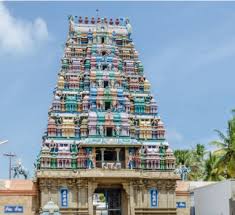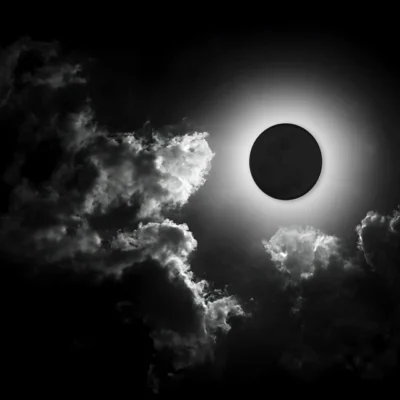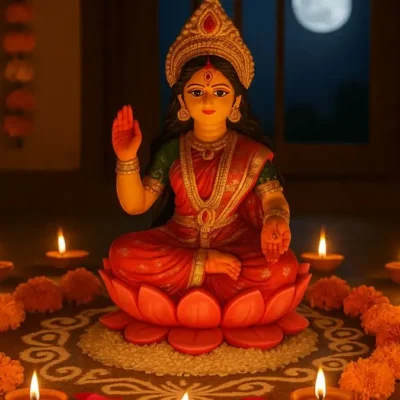Thirupparaithurai Sri Dharukavaneswarar Temple, Trichy

Address
Thirupparaithurai Sri Dharukavaneswarar Temple, Thiruparaithurai Post, Trichy district Tamil Nadu – 639 115. Tele: +91- 99408 43571.
Deity
Paraithurainathar, Amman: Pasumpon Mayilambal
Introduction
- Location: Srirangam Taluk, Tiruchirappalli District, Tamil Nadu, India
- Distance: 16 km from Trichy
- Connectivity:
- Trichy-Karur National Highway
- Trichy-Palakkad Railway Line (Nearest station: Elamanur)
- Etymology: Named after the abundance of Parai trees in ancient times
- Significance:
- Home to Vedapureeswarar Temple (Ancient Shiva Temple)
- One of the 276 Devara Paadal Petra Shiva Sthalams
- 3rd Shiva Sthalam on the Southern bank of the Cauvery in Chozha Nadu (Thenkarai)
- Theertham (Sacred Water): River Cauvery
- Sthala Vriksham (Sacred Tree): Parai Tree
- Other Temples:
- Shri Rajagopalan Swami Temple (150 years old, adjacent to the Shiva temple)
Puranic Significance
- Historical & Etymological Significance:
- Region was once densely covered with Parai trees.
- Shivalingam was discovered among the Parai trees, leading to the temple’s construction.
- The Parai tree (Dharuka Viruksham in Sanskrit) is the temple’s Sthala Vriksham.
- Temples near riverbanks often end with “Thurai”, hence the name Paraithurai.
- The ancient name of this place is Dharukavanam.
- 83 stone inscriptions from the times of Paranthaka Chola-I, Rajakesari Varman, Sundarapandiyan, and Krishnadeva Maharayar are present.
- Managed by Hindu Religious and Charitable Endowments Department (HR&CE), Tamil Nadu.
- Legend of Dharukavanam Sages:
- Sages of Dharukavanam were arrogant and believed themselves superior to the gods.
- To humble them, Lord Shiva asked Lord Vishnu to take the form of Mohini (a beautiful angel) to distract them.
- The sages lost focus in their penance, proving their spiritual weakness.
- Lord Shiva, disguised as Pikshandavar (a wandering mendicant), sought alms from the sages’ wives.
- The sages’ wives became enchanted by Pikshandavar, revealing their worldly attachments.
- Enraged, the sages performed a Yagna and invoked evil spirits to attack Lord Shiva.
- Lord Shiva defeated them effortlessly, teaching them a lesson in humility.
- The sages realized their mistakes, surrendered to Lord Shiva, and received his blessings.
- Celestial Worship:
- Kuberan, Indran, and Saptharishis are believed to have worshipped Lord Shiva here.
Beliefs
Those suffering from skin diseases or even cancer can worship Lord Shiva here to seek relief. Devotees believe that by worshiping the lord here, obstacles from their marriage proposals will be removed. Children facing speech impairment, especially stammering, can worship the lord here for relief.
Special Features
- Main Shrines & Deities:
- Lord Shiva and Goddess Parvathy are the primary deities.
- Other shrines include Valampuri Vinayakar, Murugan (with consorts), Natarajar, Somaskandar, Pikshandavar, Mahalakshmi, Gajalakshmi, Pancha Bhootha Lingams, Sapthamathas, Iyanar, Nalvar, 63 Nayanmars, Kangalamurthy, Mahavishnu, Durga Lakshmi, Bairavar, and Navagraham.
- The koshtam (outer sanctum) has idols of Narthana Vinayakar, Dakshinamoorthy, Arthanareeswarar (instead of Lingothbavar), Brahma, Durgai, and Chandikeswarar.
- Unique Features & Rituals:
- Lord Shiva as Pikshandavar is worshipped in the mandap as a procession deity.
- 12 zodiac signs are drawn on the mandap roof – standing under them while worshipping Lord Shiva & Pikshandavar is believed to remove planetary doshas.
- Two separate shrines for Lord Murugan:
- One as Sri Dandayuthapani.
- Another as Murugan with six faces.
- Thulasnanam (Theerthavari):
- Conducted on Aipasi (Oct-Nov) 1st day in the Cauvery River.
- Lord Shiva & Goddess Parvathy are taken on a Rishaba Vahan for the ritual.
- Believed to cleanse devotees of sins.
- Architectural & Historical Importance:
- Thirupparaithurai is one of the Sapthasthana Temples in the region along with:
- Thiruvaanaikkaval
- Thiruppainjeeli
- Thiruchenthurai
- Thiruvasi
- Thiruvedhikkudi
- Thiru Alanthurai
- Sculptures on the Nandhi Mandapam pillars:
- Thirugnanasambanthar
- Thirunavukkarasar
- Manickavasakar
- V.V. Nagappa Chettiayar (who renovated the temple).
- Meditating under the Sthala Viruksham (Parai Tree) is auspicious.
- A Shivalingam is placed under the Sthala Viruksham.
- Thirupparaithurai is one of the Sapthasthana Temples in the region along with:
- Celestial & Astrological Significance:
- Lord Suryan’s rays fall on the Shivalingam every year on Purattasi 18th day (Sep-Oct).
- Parali Vinayakar graces from a shrine outside the temple’s main tower.
- Lord Dakshinamurthy’s shrine:
- Has a Kallala (banyan) tree as a roof.
- Four lions support the four pillars.
- Lord Arthanareeswarar’s Unique Feature:
- Depicted with his Rishaba Vahan (bull mount), which is rare.
- River & Literary Mentions:
- The Cauvery River here is called “Akanda Cauvery” (meaning wide river).
- Saint Arunagirinadhar sang in praise of Lord Murugan in Thirupugazh.
- Saints Manickavasakar & Pattinathar also praised Lord Shiva of this temple.
- Medicinal Importance of Parai Tree:
- Used to treat cancer, skin diseases, snake bites, nosebleeds, diarrhea, etc.
Festivals
12-day Brahmotsavam in the Tamil month of Vaikasi (May-June). Thula Snanam (Theerthavari) on the first day of the Tamil month of Aippasi (Oct.-Nov). Vinayakar Chaturthi in the Tamil month of Aavani (Aug-Sept), Navarathri in the Tamil month of Purattasi (Sept-Oct), nnabishekam in the Tamil month of Aippasi (Oct–Nov), Thiru Karthikai in the Tamil month of Karthikai (Nov-Dec), Thiruvadhirai in the Tamil month of Markazhi (Dec-Jan) and Shivrathri in the Tamil month of Masi (Feb-Mar).
Century/Period/Age
1000-2000 years old
Managed By
Hindu Religious and Charitable Endowments (HRCE)
Nearest Bus Station
Thirupparaithurai.
Nearest Railway Station
Trichy
Nearest Airport
Trichy









